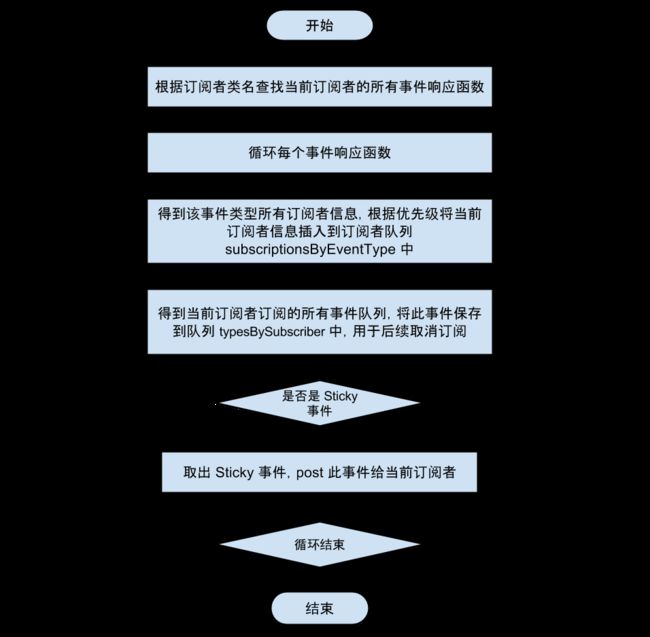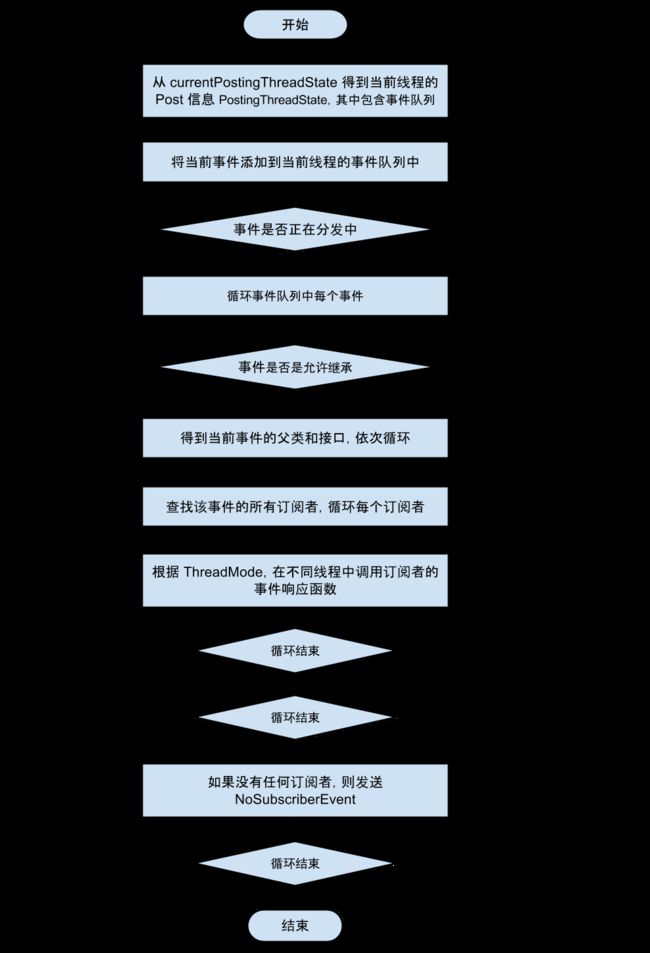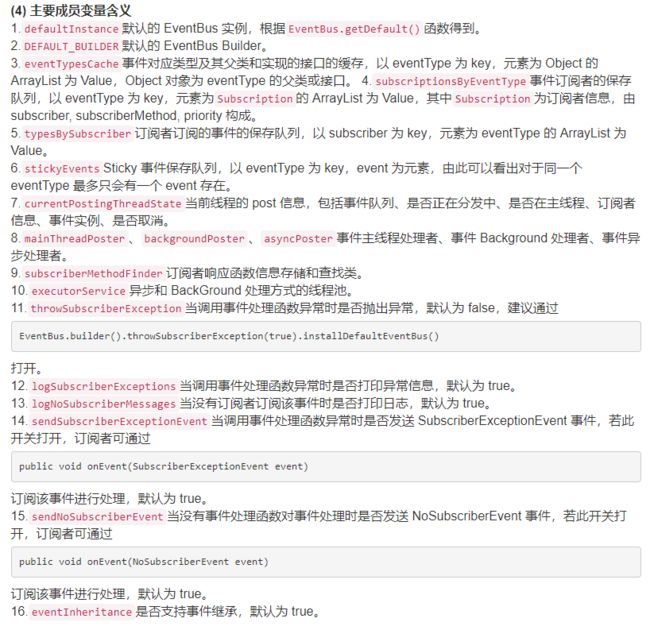1.简介
EventBus 是一个在 Android和Java上使用的 事件发布/订阅框架,通过解耦发布者和订阅者简化 Android 事件传递,事件传递既可用于 Android 四大组件间通讯,也可以用户异步线程和主线程间通讯等等。
相比传统Handle,Interface回调,BroadCastReceiver等。EventBus的优点是代码简介,使用简单,并将事件发布和订阅充分解耦。
2.简单使用
@Override
protected void onStart() { //订阅
super.onStart();
EventBus.getDefault().register(this);
}
@Override
protected void onStop() { //取消订阅
super.onStop();
EventBus.getDefault().unregister(this);
}
@Subscribe(threadMode = ThreadMode.MAIN, sticky = false, priority = 1)
public void onMessageEvent(MsgEvent event) { //响应方法
Toast.makeText(this, event.message, Toast.LENGTH_SHORT).show();
}
3.类详解
EventBus的创建(单例 + Builder )
public static EventBus getDefault() {
if (defaultInstance == null) {
synchronized (EventBus.class) {
if (defaultInstance == null) {
defaultInstance = new EventBus();
}
}
}
return defaultInstance;
}
public EventBus() {
this(DEFAULT_BUILDER);
}
EventBus(EventBusBuilder builder) {
}
单例+Build方式很常见,EventBus构造方法一般在单例中为private,在这使用public的意义在于让用户可自己构建EventBus 新建的EventBus和默认的实例发布和订阅事件都是相互隔离的,互不干扰。新建一个EventBus:
EventBus mEventBus = EventBus.builder().addIndex(new MyEventBusIndex()).build();
3.1订阅逻辑
- 先找订阅者A下所有订阅方法。
- 以A订阅的事件类型为分别key,A+A的订阅方法(key类型)为value放进subscriptionsByEventType Map中
- 以A类名为key,A中的订阅方法参数类型为value放入typesBySubscriber Map中
- 如果是订阅了粘滞事件的订阅者,从粘滞事件缓存区获取之前发送过的粘滞事件,响应这些粘滞事件。
来自CodeKK分析EventBus订阅流程图
public void register(Object subscriber) {
Class subscriberClass = subscriber.getClass();
//找到该类下所有订阅方法。(被Subscribe注解标识的方法)
List subscriberMethods = subscriberMethodFinder.findSubscriberMethods(subscriberClass);
synchronized (this) {
for (SubscriberMethod subscriberMethod : subscriberMethods) {
//把类和方法关联起来
subscribe(subscriber, subscriberMethod);
}
}
}
// Must be called in synchronized block
private void subscribe(Object subscriber, SubscriberMethod subscriberMethod) {
//发送事件类型,比如是String
Class eventType = subscriberMethod.eventType;
//把订阅者和方法组合成一个对象Subscription 。
Subscription newSubscription = new Subscription(subscriber, subscriberMethod);
//把订阅了指定类型(如String)的Subscriptions 放进subscriptionsByEventType中
//如订阅了String类型的有什么类,这些类中有什么方法。
CopyOnWriteArrayList subscriptions = subscriptionsByEventType.get(eventType);
if (subscriptions == null) {
subscriptions = new CopyOnWriteArrayList<>();
subscriptionsByEventType.put(eventType, subscriptions);
} else {
if (subscriptions.contains(newSubscription)) {
throw new EventBusException("Subscriber " + subscriber.getClass() + " already registered to event "
+ eventType);
}
}
int size = subscriptions.size();
for (int i = 0; i <= size; i++) {
if (i == size || subscriberMethod.priority > subscriptions.get(i).subscriberMethod.priority) {
subscriptions.add(i, newSubscription);
break;
}
}
//typesBySubscriber包含了一个类订阅了那些类型事件
//如TestActivity有两个响应方法,一个事件是String,一个是int
List> subscribedEvents = typesBySubscriber.get(subscriber);
if (subscribedEvents == null) {
subscribedEvents = new ArrayList<>();
typesBySubscriber.put(subscriber, subscribedEvents);
}
subscribedEvents.add(eventType);
//是sticky方法则取出对应的sticky事件post给当前方法
if (subscriberMethod.sticky) {
if (eventInheritance) {
// Existing sticky events of all subclasses of eventType have to be considered.
// Note: Iterating over all events may be inefficient with lots of sticky events,
// thus data structure should be changed to allow a more efficient lookup
// (e.g. an additional map storing sub classes of super classes: Class -> List).
Set, Object>> entries = stickyEvents.entrySet();
for (Map.Entry, Object> entry : entries) {
Class candidateEventType = entry.getKey();
if (eventType.isAssignableFrom(candidateEventType)) {
Object stickyEvent = entry.getValue();
checkPostStickyEventToSubscription(newSubscription, stickyEvent);
}
}
} else {
Object stickyEvent = stickyEvents.get(eventType);
checkPostStickyEventToSubscription(newSubscription, stickyEvent);
}
}
}
3.2发送&响应事件
- 从ThreadLocal中取出当前事件分发封装对象PostingThreadState,从该对象中取出发送事件的事件队列,把要post的事件加入此队列。
- 如果PostingThreadState不是正在发送事件,则不断从队列中取出事件。分发给订阅了此事件的方法。
3.根据每个响应方法的ThreadMode不同,采用不同的Poster响应事件。
来自CodeKK分析EventBus Post流程图
3.2.1ThreadMode 的5种类型。
POSTING: 默认的ThreadMode 类型,表示在post线程直接执行响应订阅方法,不管是主线程还是子线程。所以在主线程时不能有时不能有耗时操作。
MAIN:在主线程响应订阅方法,如果post在主线程则直接响应,如果不是则加入队列用Handler处理消息,适合必须在主线程处理事件,所以不能做耗时操作
MAIN_ORDERED:和MAIN类似,但是不会根据post是否在主线程做出响应,而是直接加入队列用Handler处理,确保Post调用不会阻塞。
BACKGROUND:如果post不在主线程,则直接响应方法,在主线程则加入队列使用BackgroundPoster处理消息。这里是启动唯一的后台线程处理响应方法,事件多了就会阻塞等待前面事件完成。所以使用场景为:操作轻微耗时且不会过于频繁,即一般的耗时操作都可以放在这里
ASYNC:不论post在哪个线程,直接使用线程池中的空闲线程处理。和BACKGROUND不同,这里不会阻塞。适合耗时操作
3.2.2分析下BackgroundPoster的"唯一"线程
enqueue时会用synchronized 锁住当前BackgroundPoster 对象,必须前面的事件处理完了才能继续处理下个事件。虽然是用的线程池处理事件。但是在某一时刻只有唯一的一个线程在处理事件。
final class BackgroundPoster implements Runnable, Poster {
private final PendingPostQueue queue;
private final EventBus eventBus;
private volatile boolean executorRunning;
BackgroundPoster(EventBus eventBus) {
this.eventBus = eventBus;
queue = new PendingPostQueue();
}
public void enqueue(Subscription subscription, Object event) {
PendingPost pendingPost = PendingPost.obtainPendingPost(subscription, event);
synchronized (this) { //等待。
queue.enqueue(pendingPost);
if (!executorRunning) {
executorRunning = true;
eventBus.getExecutorService().execute(this); //处理事件
}
}
}
@Override
public void run() {
try {
try {
while (true) {
//最多等1s
PendingPost pendingPost = queue.poll(1000);
if (pendingPost == null) {
synchronized (this) {
// Check again, this time in synchronized
pendingPost = queue.poll();
if (pendingPost == null) {
executorRunning = false;
return;
}
}
}
eventBus.invokeSubscriber(pendingPost);
}
} catch (InterruptedException e) {
eventBus.getLogger().log(Level.WARNING, Thread.currentThread().getName() + " was interruppted", e);
}
} finally {
executorRunning = false;
}
}
}
AsyncPoster 则是并行执行的,每个事件直接入队用空闲线程处理。
class AsyncPoster implements Runnable, Poster {
private final PendingPostQueue queue;
private final EventBus eventBus;
AsyncPoster(EventBus eventBus) {
this.eventBus = eventBus;
queue = new PendingPostQueue();
}
public void enqueue(Subscription subscription, Object event) {
PendingPost pendingPost = PendingPost.obtainPendingPost(subscription, event);
queue.enqueue(pendingPost);
eventBus.getExecutorService().execute(this);
}
@Override
public void run() {
PendingPost pendingPost = queue.poll();
if(pendingPost == null) {
throw new IllegalStateException("No pending post available");
}
eventBus.invokeSubscriber(pendingPost);
}
}
3.2.3看下发送Sticky事件
也是调用post,但之前先把事件添加进缓存。对应在register时,保存订阅方法时,如果该方法时sticky的。则要从stickyEvents取出事件执行该方法。所以这刚注册的方法也能执行之前发送的消息,完成粘性功能。
public void postSticky(Object event) {
synchronized (stickyEvents) {
stickyEvents.put(event.getClass(), event);
}
// Should be posted after it is putted, in case the subscriber wants to remove immediately
post(event);
}
4.主要成员变量含义
查看地址
5.使用EventBus可优化点
- 开启索引,可以在寻找订阅方法时不适用反射,提升效率
开启索引
EventBus mEventBus = EventBus.builder().addIndex(new MyEventBusIndex()).build();
//寻找订阅者里的方法。
List findSubscriberMethods(Class subscriberClass) {
List subscriberMethods = METHOD_CACHE.get(subscriberClass);
if (subscriberMethods != null) {
return subscriberMethods;
}
if (ignoreGeneratedIndex) { //默认false
//反射
subscriberMethods = findUsingReflection(subscriberClass);
} else {
//从MyEventBusIndex找,找不到用反射
subscriberMethods = findUsingInfo(subscriberClass);
}
if (subscriberMethods.isEmpty()) {
throw new EventBusException("Subscriber " + subscriberClass
+ " and its super classes have no public methods with the @Subscribe annotation");
} else {
METHOD_CACHE.put(subscriberClass, subscriberMethods);
return subscriberMethods;
}
}
- eventInheritance是否使用事件继承,默认为true。
例如:B继承与A,发送事件B会也发送A。
可以关闭设置为false。提升性能。


